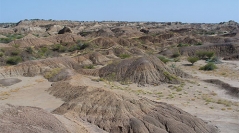

 Comptes Rendus Palevol
21 (30) - Pages 681-705
Comptes Rendus Palevol
21 (30) - Pages 681-705We describe otter remains (Lutrinae Bonaparte, 1838) from the Plio-Pleistocene of the Lower Omo Valley of southwestern Ethiopia. We report isolated lower and upper teeth of Torolutra sp. dated to c. 3.3 Ma, dental specimens and a femur of Enhydriodon Falconer, 1868, attributed to a new species, dated between c. 3.4 Ma and 2.5 Ma, as well as a humerus of Lutrinae indet. dated between c. 1.9 Ma and 1.8 Ma. The new species Enhydriodon omoensis n. sp. is the largest species of the genus discovered so far. It is even larger than its close relative E. dikikae Geraads, Alemseged, Bobe & Reed, 2011, a Pliocene lion-sized otter from the Afar region and potentially from eastern Turkana. Based on stable oxygen and carbon isotope analyses, we found that Enhydriodon from the Lower Omo Valley could have been terrestrial and fed on both aquatic and terrestrial prey, acquired by either hunting or scavenging. It filled a unique ecological niche in the past communities co-existing with australopithecines. Enhydriodon and Torolutra Petter, Pickford & Howell, 1991 went extinct in Africa around the Plio-Pleistocene transition, along with many large-sized and ecologically specialized carnivorans. This extinction event could be linked to the many geological, climate, and biotic changes occurring in the eastern African rift during this period, notably the incursion of early hominins into the carnivore guild.
An erratum has been added to this article.
Otters, carnivorans, Africa, ecological niche, stable isotopes, new species